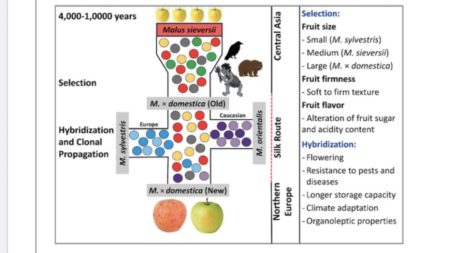- Just back from a nice holiday, and greeted by Jeremy’s latest newsletter, which includes, among many delights, a post from Old European Culture on black sheep in the Balkans.
- Traditional salt-tolerant rice varieties making a comeback in India.
- Traditional melon varieties exhibited by genebank in Spain.
- Trying to make the most of traditional olive varieties.
- Traditional foods are depicted in stone on Seville’s cathedral.
- And more recent attempts to celebrate biodiversity in art.
- I guess one could call traditional these old peaches that used to be grown by the Navajo. Have blogged about them before, check it out.
- No doubt that amaranth is a traditional crop in Central America. I doubt that it will “feed the world,” but it can certainly feed a whole bunch more people. Thanks to people like Roxanne Swentzell.
- There’s nothing more traditional than yams in Papua New Guinea. For 50,000 years.
- How to remix a traditional food like stuffed avocado.
- How many of the traditional recipes in these Abbasid and later Arab cookbooks have been remixed, I wonder?
Nibbles: Eat like a Roman, Diverse palate, Sustainable diet myths, Trees
- Wanna eat like an ancient Roman?
- But was ancient Rome’s food system geographically diversified?
- And how healthy and sustainable were their diets anyway?
- Well, I bet they had agroforestry.
Apple domestication visualized
The chapter on the Origin of the Domesticated Apples in the recent book on The Apple Genome has a really useful diagram which I hope I won’t get into trouble for reproducing here.

That really is worth a thousand words and more. Wish we had similar ones for all crops.
Nibbles: Trees & poverty, Climate change myths, Trees & landscapes, Trees in the pandemic, Community genebanks
- How trees can alleviate poverty.
- How trees can help fight climate change. And how they cannot.
- How trees can contribute to diverse sustainable landscapes.
- How wild fruit trees (among other things) helped in the Covid-19 crisis.
- Not entirely sure if there are any trees among the burgeoning community seedbanks of China.
Brainfood: Plant services, Ornamental conservation, Cinnamon, Avocado, Apricot double, Apple, Date palm, Bambara groundnut, Amaranth, On farm research, Fertilizer subsidies
- A global database of plant services for humankind. 13% of over 13,000 plant genera have been recorded as human food. But twice as many are described as “ornamentals.”
- Horticultural plant use as a so-far neglected pillar of ex situ conservation. Something we can do about those ornamentals. But not only ornamentals, surely.
- “Ceylon cinnamon”: Much more than just a spice. But not, alas, an ornamental.
- Exploring genetic diversity of lowland avocado (Persea americana Mill.) as a genetic reservoir for breeding. Plus it’s a handsome tree.
- Population genomics of apricots unravels domestication history and adaptive events. Separate Chinese and European genepools, deriving from independent domestications from distinct populations. No word on which is more ornamental.
- Diversity and Relationships among Neglected Apricot (Prunus armeniaca L.) Landraces Using Morphological Traits and SSR Markers: Implications for Agro-Biodiversity Conservation. Get farmers to grow varietal mixtures for maximum ornamental value — and conservation.
- Unraveling a genetic roadmap for improved taste in the domesticated apple. No evidence of selection for increased sugar content. And ornamental value?
- Molecular clocks and archaeogenomics of a Late Period Egyptian date palm leaf reveal introgression from wild relatives and add timestamps on the domestication. Ancient hybrid origin for the coincidentally ornamentally and otherwise valuable food crop, followed by introgression from both wild close congeneric relatives.
- Genetic diversity and population structure analysis of bambara groundnut (Vigna subterrenea L) landraces using DArT SNP markers. 3 groups: W Africa, Central Africa, E + S Africa. No word on which would make the most attractive ornamentals.
- A chromosome-level Amaranthus cruentus genome assembly highlights gene family evolution and biosynthetic gene clusters that may underpin the nutritional value of this traditional crop. Yeah, but where are the genes that make it ornamental too?
- How accurate are yield estimates from crop cuts? Evidence from smallholder maize farms in Ethiopia. More accurate than estimates of horticultural attractiveness, I suspect.
- The unintended consequences of the fertilizer subsidy program on crop species diversity in Mali. Spoiler alert: they’re bad. Fortunately, ornamentals don’t attract subsidies.